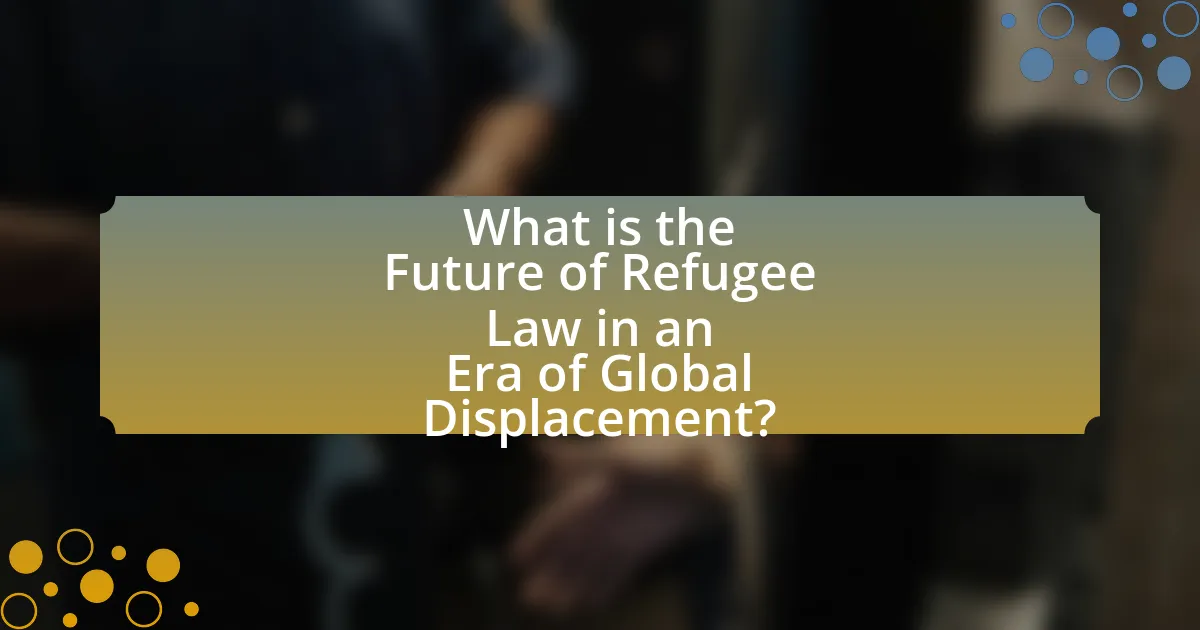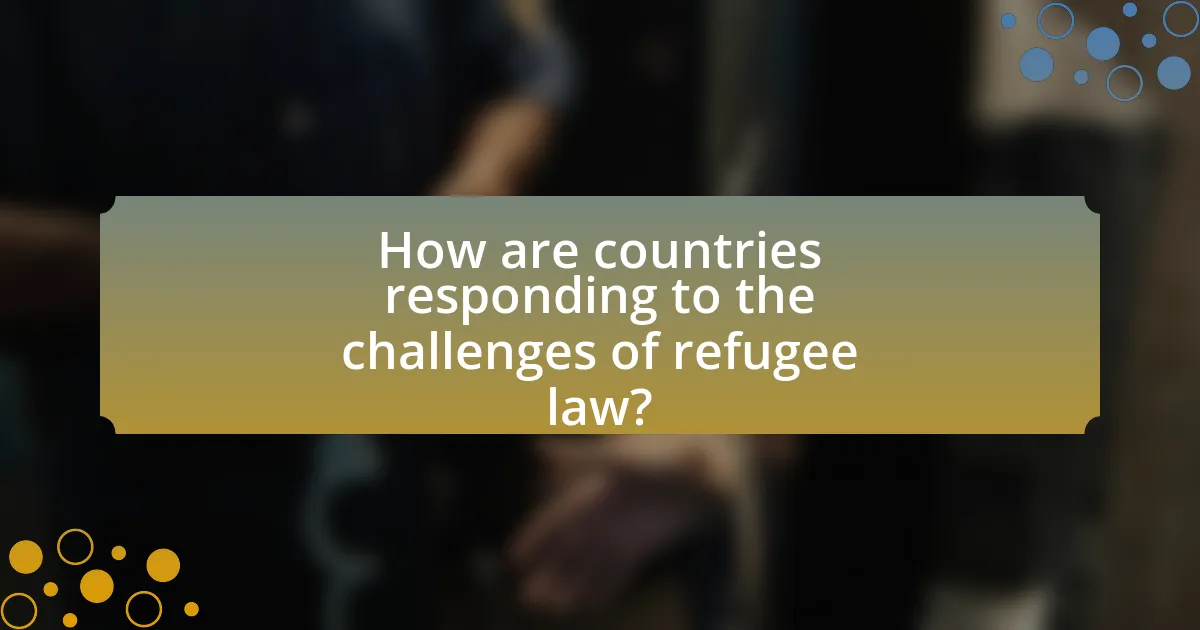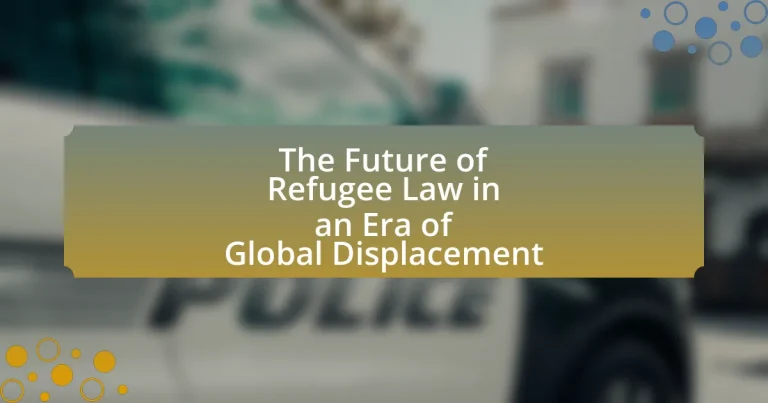The article examines the future of refugee law in the context of unprecedented global displacement, highlighting the need for more flexible and inclusive legal frameworks. With over 89 million people forcibly displaced worldwide, traditional definitions of refugees are being challenged, necessitating adaptations to include climate migrants and those fleeing new forms of violence and persecution. Key factors driving this displacement include armed conflict, persecution, and climate change, prompting countries to reconsider their asylum policies and enhance international cooperation. The article also discusses the role of international treaties, societal attitudes, and the impact of technology on refugee law, emphasizing the importance of evolving legal frameworks to effectively address contemporary challenges in refugee protection.

What is the Future of Refugee Law in an Era of Global Displacement?
The future of refugee law in an era of global displacement is likely to involve a shift towards more flexible and inclusive legal frameworks that address the complexities of modern migration. As global displacement reaches unprecedented levels, with over 89 million people forcibly displaced worldwide as of 2021 according to the UNHCR, existing legal structures may need to adapt to encompass not only traditional refugees but also climate migrants and those fleeing violence and persecution in new forms. This evolution may include the development of regional agreements and collaborative international efforts to ensure protection and support for displaced populations, reflecting the need for a comprehensive approach to global displacement challenges.
How is global displacement reshaping refugee law?
Global displacement is reshaping refugee law by necessitating the adaptation of legal frameworks to address the increasing complexity and scale of forced migration. Traditional refugee definitions, primarily based on persecution due to race, religion, nationality, or political opinion, are being challenged as new forms of displacement emerge, such as those caused by climate change and armed conflict. For instance, the United Nations High Commissioner for Refugees (UNHCR) reported that in 2021, there were over 89 million forcibly displaced people worldwide, highlighting the urgent need for legal recognition of diverse causes of displacement. This shift is prompting countries to reconsider their asylum policies and expand protections to include individuals fleeing environmental disasters and other non-traditional threats, thereby evolving the scope of refugee law to be more inclusive and responsive to contemporary challenges.
What are the key factors contributing to increased global displacement?
The key factors contributing to increased global displacement include armed conflict, persecution, and climate change. Armed conflicts, such as the Syrian civil war, have led to millions of refugees fleeing their homes; as of 2021, over 6.6 million Syrians were displaced. Persecution based on ethnicity, religion, or political beliefs, exemplified by the Rohingya crisis in Myanmar, has also forced large populations to seek safety elsewhere. Additionally, climate change is increasingly displacing people, with the Internal Displacement Monitoring Centre reporting that in 2020 alone, 30.7 million people were displaced by disasters linked to climate events. These factors collectively drive the rising numbers of displaced individuals globally.
How do international treaties adapt to changing displacement patterns?
International treaties adapt to changing displacement patterns by incorporating flexible frameworks that allow for the recognition of new forms of displacement, such as climate-induced migration. For instance, the 2018 Global Compact for Safe, Orderly and Regular Migration acknowledges the need for international cooperation in addressing the complexities of migration, including those driven by environmental factors. This adaptation is further evidenced by the evolving interpretations of existing treaties, such as the 1951 Refugee Convention, which has been applied to include individuals fleeing situations of generalized violence and human rights abuses, thereby expanding the definition of who qualifies for protection. These adaptations reflect a responsive approach to the dynamic nature of global displacement, ensuring that international legal instruments remain relevant and effective in protecting vulnerable populations.
Why is the evolution of refugee law important in today’s context?
The evolution of refugee law is important in today’s context because it addresses the increasing complexities of global displacement caused by conflicts, climate change, and persecution. As of 2023, the United Nations High Commissioner for Refugees reported that over 26 million people are recognized as refugees, highlighting the urgent need for legal frameworks that adapt to contemporary challenges. This evolution ensures that refugee rights are protected and that legal definitions keep pace with the realities faced by displaced individuals, such as the rise of climate refugees, which traditional laws often do not adequately cover. By updating and expanding refugee law, countries can better respond to humanitarian crises and uphold international obligations, thereby fostering a more equitable and just global response to displacement.
What historical precedents influence current refugee law?
The historical precedents that influence current refugee law include the 1951 Refugee Convention and its 1967 Protocol, which established the legal definition of a refugee and the principle of non-refoulement. These documents were shaped by the aftermath of World War II and the Holocaust, reflecting the urgent need to protect individuals fleeing persecution. Additionally, the Universal Declaration of Human Rights (1948) laid the groundwork for recognizing the rights of all individuals, including refugees. The Geneva Conventions also contributed by emphasizing humanitarian protections during conflicts, which indirectly affects refugee law. These foundational texts and events underscore the international community’s commitment to safeguarding the rights and dignity of displaced persons.
How do societal attitudes towards refugees impact legal frameworks?
Societal attitudes towards refugees significantly influence legal frameworks by shaping public policy and legislative responses. When communities exhibit positive attitudes, governments are more likely to enact inclusive laws that facilitate refugee integration, as seen in countries like Canada, which has implemented supportive immigration policies in response to favorable public sentiment. Conversely, negative societal attitudes can lead to restrictive legal measures, such as increased border controls and limited asylum options, as evidenced by the tightening of refugee laws in several European nations during periods of public backlash against immigration. These dynamics illustrate that the legal treatment of refugees is often a reflection of prevailing societal views, impacting their rights and protections.
What challenges does refugee law face in the current global landscape?
Refugee law faces significant challenges in the current global landscape, primarily due to increasing displacement caused by conflicts, climate change, and political instability. The United Nations High Commissioner for Refugees reported that as of mid-2023, there were over 32 million refugees worldwide, highlighting the urgent need for effective legal frameworks. Additionally, many countries are tightening their borders and implementing restrictive immigration policies, which complicates the application of existing refugee laws. The rise of anti-immigrant sentiment in various nations further undermines the protection of refugees, as legal definitions and rights are often contested. Furthermore, the lack of international cooperation and burden-sharing among states exacerbates the situation, making it difficult to address the needs of displaced populations adequately.
How do political climates affect the enforcement of refugee rights?
Political climates significantly influence the enforcement of refugee rights by shaping government policies and public attitudes towards refugees. In authoritarian regimes, for instance, restrictive policies may be implemented that limit asylum applications and curtail legal protections, as seen in countries like Hungary, where laws have been enacted to deter asylum seekers. Conversely, in more liberal democracies, political support for refugee rights can lead to stronger legal frameworks and protections, exemplified by Canada’s commitment to resettling refugees and providing comprehensive support services. The political discourse surrounding refugees, often swayed by economic conditions and security concerns, directly impacts the willingness of states to uphold international refugee laws, such as the 1951 Refugee Convention.
What role do non-governmental organizations play in advocating for refugee law reforms?
Non-governmental organizations (NGOs) play a crucial role in advocating for refugee law reforms by influencing policy, raising awareness, and providing legal assistance. NGOs such as the International Rescue Committee and Refugees International actively engage with lawmakers to promote changes that enhance the protection of refugees. They conduct research and publish reports that highlight gaps in existing laws and the urgent need for reforms, thereby informing public discourse and shaping legislative agendas. For instance, the UNHCR’s Global Trends report indicates that over 26 million refugees were displaced globally in 2020, underscoring the necessity for updated legal frameworks to address their needs effectively. Through grassroots mobilization and partnerships with other stakeholders, NGOs amplify the voices of refugees, ensuring their experiences and rights are central to the reform process.

How are countries responding to the challenges of refugee law?
Countries are responding to the challenges of refugee law by implementing a mix of stricter border controls, enhanced asylum procedures, and international cooperation. For instance, many nations have tightened their immigration policies to manage the influx of refugees, while simultaneously establishing expedited asylum processes to address claims more efficiently. Additionally, countries are increasingly engaging in bilateral and multilateral agreements to share the responsibility of hosting refugees, as seen in the Global Compact on Refugees adopted by the United Nations in 2018, which aims to improve international cooperation and support for refugee-hosting countries. These responses reflect a growing recognition of the complexities surrounding refugee law in the context of global displacement.
What innovative legal frameworks are emerging in response to global displacement?
Innovative legal frameworks emerging in response to global displacement include the Global Compact on Refugees and the Global Compact for Safe, Orderly and Regular Migration. These frameworks aim to enhance international cooperation and provide comprehensive solutions for refugees and migrants. The Global Compact on Refugees, adopted by the United Nations in 2018, emphasizes responsibility-sharing among nations and promotes the inclusion of refugees in host communities, thereby addressing the challenges of displacement more effectively. Additionally, the Global Compact for Migration outlines a cooperative approach to managing migration, focusing on the protection of migrants’ rights and the facilitation of safe migration pathways. These frameworks reflect a shift towards more collaborative and rights-based approaches to displacement, responding to the increasing complexity of global migration patterns.
How do regional agreements differ from international conventions on refugee law?
Regional agreements on refugee law differ from international conventions primarily in their scope and application. Regional agreements are tailored to specific geographic areas and often address the unique circumstances and needs of countries within that region, such as the 1969 OAU Refugee Convention in Africa, which expands the definition of a refugee to include those fleeing generalized violence. In contrast, international conventions, like the 1951 Refugee Convention, provide a universal framework applicable to all signatory states, focusing on the protection of refugees based on a standardized definition and rights. This distinction highlights how regional agreements can be more flexible and responsive to local contexts, while international conventions aim for a consistent global standard in refugee protection.
What are the implications of bilateral agreements on refugee protection?
Bilateral agreements significantly impact refugee protection by establishing specific responsibilities and procedures between two countries regarding the treatment of refugees. These agreements can lead to enhanced cooperation in managing refugee flows, but they may also result in reduced protections if one country prioritizes border control over humanitarian obligations. For instance, the 2016 EU-Turkey deal aimed to curb irregular migration by returning refugees to Turkey, raising concerns about the adequacy of protection standards in Turkey. Such agreements can create a framework that either strengthens or undermines the rights of refugees, depending on the terms negotiated and the commitment of the involved states to uphold international refugee law.
How are countries balancing national interests with international obligations?
Countries balance national interests with international obligations by implementing policies that prioritize domestic security while adhering to international treaties and agreements. For instance, many nations have signed the 1951 Refugee Convention, which obligates them to protect refugees, yet they often impose stricter border controls and asylum processes to manage the influx of displaced individuals. This dual approach allows countries to maintain sovereignty and address public concerns about immigration, while still fulfilling their commitments to international humanitarian standards. The United Nations High Commissioner for Refugees (UNHCR) reports that countries like Germany and Canada have developed frameworks that integrate national security measures with refugee protection, demonstrating a practical application of this balance.
What strategies are being employed to manage refugee influxes effectively?
Governments and international organizations are employing several strategies to manage refugee influxes effectively, including enhanced border control, comprehensive asylum processes, and community integration programs. Enhanced border control measures, such as increased surveillance and security personnel, aim to regulate the flow of refugees while ensuring safety. Comprehensive asylum processes involve streamlining applications and providing legal assistance to expedite decision-making, which helps reduce backlogs and uncertainty for refugees. Community integration programs focus on facilitating the social and economic inclusion of refugees, promoting access to education, healthcare, and employment opportunities. These strategies are supported by data indicating that countries implementing such measures experience better outcomes in terms of refugee well-being and social cohesion. For instance, the UNHCR reported that countries with robust integration policies see higher rates of refugee self-sufficiency and lower reliance on state support.
How do countries ensure compliance with international refugee standards?
Countries ensure compliance with international refugee standards primarily through the implementation of national laws that align with international treaties, such as the 1951 Refugee Convention and its 1967 Protocol. These legal frameworks obligate countries to protect refugees and provide them with rights, including non-refoulement, which prohibits returning refugees to places where they face serious threats to their life or freedom.
Additionally, countries often establish national asylum procedures that adhere to international guidelines, ensuring fair and efficient processing of refugee claims. For instance, the UNHCR provides technical assistance and guidelines to help nations develop their asylum systems in accordance with international standards. Furthermore, countries may engage in regular reporting and monitoring mechanisms, such as the Universal Periodic Review by the UN Human Rights Council, to assess their compliance with international obligations.
These measures collectively reinforce a country’s commitment to uphold refugee rights and ensure adherence to established international standards.

What does the future hold for refugee law and policy?
The future of refugee law and policy is likely to focus on increased international cooperation and the adaptation of legal frameworks to address the complexities of global displacement. As conflicts, climate change, and economic instability drive more people to seek refuge, existing laws may evolve to incorporate broader definitions of refugees and provide more comprehensive protections. For instance, the Global Compact on Refugees, adopted by the United Nations in 2018, emphasizes the need for shared responsibility among nations, suggesting a shift towards collaborative approaches in managing refugee crises. This trend is supported by rising advocacy for human rights and the recognition of the need for sustainable solutions, indicating that future policies will likely prioritize both immediate humanitarian assistance and long-term integration strategies.
How can technology influence the future of refugee law?
Technology can significantly influence the future of refugee law by enhancing data collection, improving communication, and streamlining legal processes. For instance, digital platforms can facilitate the registration of refugees, allowing for more accurate tracking of their status and needs. Additionally, artificial intelligence can assist in analyzing asylum claims, thereby expediting decision-making processes. A study by the United Nations High Commissioner for Refugees (UNHCR) highlights that technology can reduce processing times by up to 50%, demonstrating its potential to transform legal frameworks and improve outcomes for refugees.
What role does data play in shaping refugee policies?
Data plays a critical role in shaping refugee policies by providing evidence-based insights that inform decision-making. Policymakers utilize data on refugee demographics, migration patterns, and socio-economic impacts to develop effective strategies for integration and support. For instance, the United Nations High Commissioner for Refugees (UNHCR) reports that accurate data collection helps identify the needs of refugees, enabling governments to allocate resources efficiently and tailor services accordingly. Furthermore, data-driven analysis can reveal trends in displacement, allowing for proactive policy adjustments to address emerging challenges in global displacement scenarios.
How can digital platforms enhance refugee access to legal resources?
Digital platforms can enhance refugee access to legal resources by providing easily accessible information, legal advice, and support services through online tools and applications. These platforms can offer multilingual resources, enabling refugees from diverse backgrounds to understand their rights and legal options. For instance, organizations like Refugee Law Project and Legal Aid Society have developed online portals that compile legal information tailored to refugees, which can be accessed anytime and anywhere, thus overcoming geographical barriers. Furthermore, studies indicate that digital legal services can significantly reduce the time and cost associated with obtaining legal assistance, making it more feasible for refugees to navigate complex legal systems.
What best practices can be adopted for effective refugee law implementation?
Effective refugee law implementation can be achieved through comprehensive legal frameworks, robust training for officials, and community engagement. Comprehensive legal frameworks ensure that national laws align with international standards, such as the 1951 Refugee Convention, which outlines the rights of refugees and the obligations of states. Robust training for officials, including law enforcement and immigration officers, enhances understanding of refugee rights and procedures, reducing the risk of violations. Community engagement fosters support for refugees, promoting social integration and awareness of their rights, which can lead to better compliance with legal standards. These practices are supported by evidence from various countries that have successfully improved their refugee systems through similar approaches.
How can collaboration between nations improve refugee protection?
Collaboration between nations can significantly improve refugee protection by enabling the sharing of resources, information, and best practices. When countries work together, they can establish comprehensive frameworks that address the needs of refugees more effectively, such as coordinated asylum processes and mutual recognition of refugee status. For instance, the 2018 Global Compact on Refugees, endorsed by the United Nations, emphasizes international cooperation to enhance the protection of refugees and support host countries. This collaborative approach can lead to more equitable burden-sharing, ensuring that no single nation bears the full responsibility for refugee populations, which is crucial given that over 26 million people were displaced globally as of 2021, according to UNHCR. By pooling resources and expertise, nations can create safer environments for refugees and improve their access to essential services, ultimately enhancing their protection and integration into host societies.
What lessons can be learned from successful refugee integration programs?
Successful refugee integration programs demonstrate that early access to language education significantly enhances integration outcomes. Programs that prioritize language training enable refugees to communicate effectively, access services, and secure employment, which are critical for their social and economic integration. For instance, a study by the Migration Policy Institute found that refugees who participated in language classes were 50% more likely to find jobs within their first year in the host country compared to those who did not receive such training. Additionally, successful programs often involve community engagement, fostering relationships between refugees and local residents, which helps reduce social isolation and build mutual understanding. Evidence from the UNHCR indicates that communities that actively involve refugees in local activities experience lower levels of xenophobia and higher levels of social cohesion.
What are the key takeaways for stakeholders in refugee law?
Key takeaways for stakeholders in refugee law include the necessity for collaboration among nations, the importance of upholding international legal standards, and the need for adaptive legal frameworks to address evolving displacement challenges. Collaboration among nations is crucial, as evidenced by the Global Compact on Refugees, which emphasizes shared responsibility and international cooperation. Upholding international legal standards, such as the 1951 Refugee Convention, ensures that refugees receive protection and rights. Additionally, adaptive legal frameworks are essential to respond to the increasing complexity of global displacement, including climate change and conflict-related migration, as highlighted by the UNHCR’s reports on emerging trends in refugee movements.


